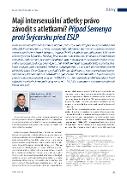| dc.contributor.author | Exner, Jan | |
| dc.date.accessioned | 2025-01-13T11:11:00Z | |
| dc.date.available | 2025-01-13T11:11:00Z | |
| dc.date.issued | 2024 | |
| dc.identifier.uri | https://hdl.handle.net/20.500.14178/2801 | |
| dc.description.abstract | Autor se v následujícím článku zabývá otázkou, jakou roli hraje Evropský soud pro lidská práva (dále jen "ESLP") při přezkumu pravidel a rozhodnutí soukromých sportovních organizací o účasti intersexuálních žen v ženské kategorii. Odpověď hledá v kontextu rozsudku senátu ESLP ve věci Semenya proti Švýcarsku. Podle něj Švýcarsko porušilo Evropskou úmluvu o ochraně lidských práv (dále jen "Úmluva") tím, že jihoafrické atletce Caster Semenye nezaručilo dostatečné institucionální a procesní záruky při obraně před údajně diskriminačními pravidly Světové atletiky. Rozhodčí soud pro sport a švýcarský federální soud při přezkumu atletických pravidel nedostatečně zohlednily práva Caster Semenyi vyplývající z Úmluvy. Rozhodnutí je kontroverzní mezi samotnými soudci, stranami sporu i sportovními organizacemi. Na základě žádosti Švýcarska se případem bude znovu zabývat velký senát ESLP. Proto autor analyzuje senátní rozsudek a hledá odpovědi na otázky, které bude velký senát řešit: Má ESLP pravomoc o stížnosti rozhodnout? Pokud ano, jak? | cs |
| dc.description.abstract | In the following article, the author addresses the question of the role of the European Court of Human Rights ("ECtHR") in reviewing the rules and decisions of private sporting organizations regarding the participation of intersex women in the women's category. It seeks an answer in the context of the ECtHR Chamber's judgment in Semenya v. Switzerland. It held that Switzerland had violated the European Convention on Human Rights ("the Convention") by failing to provide South African athlete Caster Semenya with sufficient institutional and procedural safeguards in defending herself against allegedly discriminatory World Athletics rules. The Court of Arbitration for Sport and the Swiss Federal Court failed to take sufficient account of Caster Semenya's rights under the Convention when reviewing the Athletics Rules. The decision is controversial among the judges themselves, the litigants and the sports organisations. Following a request from Switzerland, the case will be re-examined by the Grand Chamber of the ECtHR. The author therefore analyses the Chamber's judgment and seeks answers to the questions that the Grand Chamber will address: Does the ECtHR have jurisdiction to rule on the complaint? If so, how? | en |
| dc.language.iso | cs | |
| dc.relation.url | https://www.cak.cz/bulletin-advokacie | |
| dc.rights | Tento výsledek je zpřístupněn v režimu gratis open access, tj. pouze pro čtení. V souladu s § 30 zákona č. 121/2000 Sb., autorského zákona, lze plný text z repozitáře také stáhnout, případně vytisknout, ale pouze pro osobní potřebu. | cs |
| dc.rights | The fulltext is published in the repository as read-only, i.e. in gratis open access mode. Repository visitors are entitled to download and print the fulltext published without a licence for their personal use only (in accordance with § 30 of Act No. 121/2000 Coll., the Copyright Act). | en |
| dc.title | Mají intersexuální atletky právo závodit s atletkami? Případ Semenya proti Švýcarsku před ESLP | cs |
| dcterms.accessRights | openAccess | |
| dc.date.updated | 2025-03-24T06:11:18Z | |
| dc.subject.keyword | Caster Semenya | cs |
| dc.subject.keyword | intersex | cs |
| dc.subject.keyword | sport | cs |
| dc.subject.keyword | atletika | cs |
| dc.subject.keyword | diskriminace | cs |
| dc.subject.keyword | Evropský soud pro lidská práva | cs |
| dc.subject.keyword | Evropská úmluva o ochraně lidských právech | cs |
| dc.subject.keyword | Rozhodčí soud pro sport | cs |
| dc.subject.keyword | Švýcarský federální tribunál | cs |
| dc.subject.keyword | Caster Semenya | en |
| dc.subject.keyword | intersex | en |
| dc.subject.keyword | sport | en |
| dc.subject.keyword | athletics | en |
| dc.subject.keyword | discrimination | en |
| dc.subject.keyword | European Court of Human Rights | en |
| dc.subject.keyword | European Convention on Human Rights | en |
| dc.subject.keyword | Court of Arbitration for Sport | en |
| dc.subject.keyword | Swiss Federal Tribunal | en |
| dc.identifier.eissn | 1805-8280 | |
| dc.relation.fundingReference | info:eu-repo/grantAgreement/MSM//UNCE24/SSH/018 | |
| dc.relation.fundingReference | info:eu-repo/grantAgreement/UK/COOP/COOP | |
| dc.date.embargoStartDate | 2025-03-24 | |
| dc.type.obd | 73 | |
| dc.type.version | info:eu-repo/semantics/draft | |
| dc.identifier.obd | 648074 | |
| dc.subject.rivPrimary | 50000::50500::50501 | |
| dc.subject.rivSecondary | 50000::50500::50501 | |
| dcterms.isPartOf.name | Bulletin Advokacie | |
| dcterms.isPartOf.issn | 1210-6348 | |
| dcterms.isPartOf.journalYear | 2024 | |
| dcterms.isPartOf.journalVolume | 2024 | |
| dcterms.isPartOf.journalIssue | 5 | |
| uk.faculty.primaryId | 107 | |
| uk.faculty.primaryName | Právnická fakulta | cs |
| uk.faculty.primaryName | Faculty of Law | en |
| uk.department.primaryId | 162 | |
| uk.department.primaryName | Katedra evropského práva | cs |
| uk.department.primaryName | Department of European Law | en |
| dc.title.translated | Do intersex female athletes have the right to compete with male athletes? Semenya v. Switzerland before the ECHR | en |
| dc.description.pageRange | 31-35 | |
| dc.type.obdHierarchyCs | ČLÁNEK V ČASOPISU::článek v časopisu::původní článek | cs |
| dc.type.obdHierarchyEn | JOURNAL ARTICLE::journal article::original article | en |
| dc.type.obdHierarchyCode | 73::152::206 | en |
| uk.displayTitle | Mají intersexuální atletky právo závodit s atletkami? Případ Semenya proti Švýcarsku před ESLP | cs |
| uk.displayTitle.translated | Do intersex female athletes have the right to compete with male athletes? Semenya v. Switzerland before the ECHR | en |

